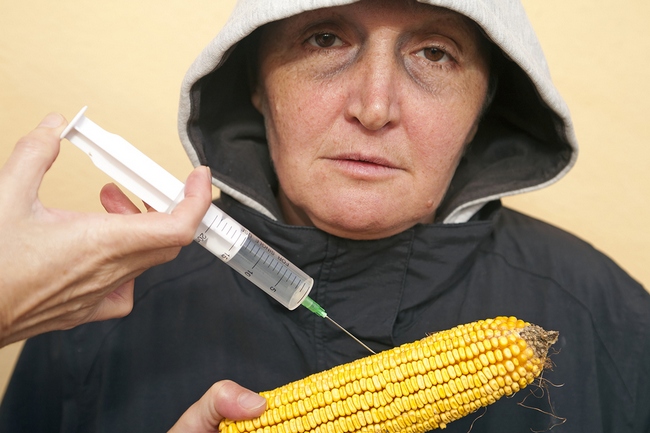- Make It Yourself Lavender Heart-Shaped Bath Bombs!
- 20 Things You Never Knew About “Down There”
- 12 Best Foods For Those Suffering From Arthritis Pain
- 12 Personal Hygiene Mistakes Almost Everyone Makes (Mom Never Told You About #4!)
- 15 Medicinal Plants And Herbs From The Cherokee People
- 12 Mind-Blowing Benefits Of Drinking Coconut Water During Pregnancy
- 12 Outstanding Winter Foods That Won’t Fatten You Up Like A Christmas Turkey
Food Labels Trick You into Eating GMO Food

Photo credit: bigstock.com
You might think that you are one of the more savvy shoppers because you take the time to read food labels and only buy foods that say natural, organic, or GMO free. Reading food labels is a good thing, no one would ever tell you otherwise, but did you know that many of those food labels are…well, let’s put it this way, they aren’t exactly truthful.
One of the reasons they aren’t completely truthful is due to the labeling laws in this country. There really are no guidelines for what “natural” means. The water in a can of GMO corn is natural, isn’t it? This is misrepresentation at its finest.
Consumer Reports has a better labeling standard than the US government does! Their limit for whether or not a food product can be considered GMO Free is 0.9, just under one percent. Consumer Reports teste 80 samples of products that claimed they were GMO free, natural, or organic. Now, many of these products were not completely GMO, such as a can of corn, but many of them contained some items that could be GMO, such as apple juice, for example, which can be sweetened with GMO corn syrup or GMO sugar beets.
None of the items that were labeled No-GMO or GMO Free, or those that were labeled organic exceeded Consumer Reports limit of less than 1 percent. Almost everything simply labeled as “natural” did.
The “natural” or “100 percent natural” or “completely natural” is nothing more than a big marketing scam! The industries that produce these foods don’t want you to know that their products contain GMOs and they spend millions of dollars every year lobbying congress and fighting labeling laws. About 92 percent of American consumers say that they WANT their labels to tell them the truth about their food, including if it contains any GMOs, and if so, how much. To tell the truth, it’s kind of hard to figure out, isn’t it? If their foods are so “natural” and safe, if GMOs are harmless, then why are food manufacturers trying so hard to fight labeling laws? This is a rhetorical question, of course, as food manufacturers know all too well, as most Americans do, that their foods are anything but natural or safe.
In fact, even products that claimed that they were Non-GMO, in fact, did contain GMO products. One brand of tortilla chips, in big, bold letters, stated that they were Non-GMO but, when tested by Consumer Reports, found that these chips contained more than 75 percent GMO corn. Always look for the Certified Organic label, the “USDA Organic,” or the “Non-GMO Project” seal is on your product. Those are reliable labels you can trust.
Continue to Page 2

Photo credit: bigstock
Keep reading for some other top tips you can use to spot GMOs and avoid them.
1. The Ingredient List
If the ingredient list on your package says anything about corn or soy and it doesn’t have the Certified Organic or Non-GMO Project seal, which means it contains GMO corn and/or soy. This also holds true for canola, sugar beets, and cottonseed oil.
2. Oil and Sugar
Canola oil and sugar also come from GMO crops. Although you are better off without these kinds of foods in your diet at all, should you choose to consume them, look for labels that say ‘100 percent pure cane sugar’ or the Non-GMO Project seal on the label.
3. Prepackaged Food
This is another item that you would be wise to avoid eating as they cause many serious health concerns, but again, if you choose to consume them, you should know that there is really no way to avoid GMO contamination, artificial ingredients, artificial colors, salt, sugar or artificial sweeteners, and tons of chemical preservatives. The further away you stay from foods that come in a box, the better. Opt for whole, truly natural foods.

Photo credit: bigstock.com
4. PLC Codes on Produce
Although many people claim that PLC codes on fresh produce can tell you whether or not the food is GMO, it’s not always a reliable means of determining a foods origin. There are also some foods that don’t contain those PLC codes. Unless your market specifically states that these are “Non-GMO,” you should assume the following produce IS GMO:
- Corn
- Edamame
- Zucchini
- Yellow squash (sometimes called summer squash)
- Papayas from Hawaii
- Beets
There is a GMO potato coming out soon called Simplot, so keep your eye open for that one! Read more about GMO foods to avoid.
The Big Food industry is hoping that you will be too busy working, going to Black Friday sales, and rushing home to watch Orange is the New Black or Dancing with the Stars to pay much attention to food labels or to cook from scratch at all. Sometimes you wonder if they are right. If you have ever seen the line of cars waiting at a fast food drive through about 6PM, you might begin to wonder if anyone cares. But you care, don’t you? So do we! Demand accurate food labeling from congress and don’t support the Big Food industry, and avoid GMOs every time you shop!
Sources:

































robber2112
Feb 16, 2015 at 5:20 pm
ALL GMO foods should be labeled as such. not printing this on food labels, just goes to prove they are not good to eat. Death to you Monsanto for polluting our food….